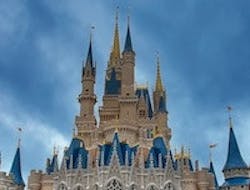Membrane Technologies Installed at Shanghai Disneyland
In 2013, Shanghai International Tourism Resort (Disney) realized that they needed to improve the quality of their make-up to the cooling water circulation system to effectively control contamination, scaling and corrosion and protect downstream system components. To accomplish its goals, the resort enlisted CHD to design and build a system using proven membrane technologies that effectively removed suspended solids, colloidal substances, chemical oxygen demand (COD), salt, and dissolved gases from the system. Ultrafiltration (UF), reverse osmosis (RO) and gas transfer membrane (GTM) technologies were included in the design.
CHD selected 3M's Liqui-Flux W10-07 UF modules as pre-treatment to RO and Liqui-Cel 10-by-28-in. GTMs as the post-treatment to remove dissolved oxygen and carbon dioxide.
The entire system is designed to handle 960 tons per day of recirculated cooling water with two independent UF units with a capacity of 640 tons per day for each rack and degassing units with a capacity of 480 tons per day for each rack. Splitting the UF and degassing systems into two racks allowed for a more mobile and modular system design.
The UF plant is designed to operate with a 65 LMH flux with 40 minutes of filtration time and 250 LMH backwash flux. A backpressure above 2.0 bar is maintained due to downstream equipment requirements and piping demands. The feed water pressure is expected to remain above 3.5 bar. In operation, the feedwater pressure is maintained at 4.0 bar and module tolerance pressure is 4.0 bar at 30˚C. An in-line turbidity meter is installed for real-time monitoring of the outlet water and a chemical enhanced backwash (CEB) system is installed with a cycle time of once per day.
Liqui-Cel GTM, also known as membrane contactors, are installed four in parallel and two in series to improve oxygen removal efficiency. The Liqui-Cel system operates in combo mode (a nitrogen sweep gas and vacuum are applied to the degassing units) to further enhance gas removal efficiency. The contactors are used for degassing because the technology can reach a low dissolved oxygen concentration of less than 10 ppb, which is difficult with conventional gas removal processes. The compact design of the Liqui-Cel membrane contactors also enabled the system builder to design small skids.
The system was commissioned in June 2014. The transmembrane pressure (TMP) of the ultrafiltration units is maintained between 0.18 bar and 0.20 bar during filtration. A chemical enhanced backwash (CEB) cycle is performed daily with CEB1 and CEB2 running every other day. Because commissioning turbidity remains consistently at 0.03 NTU with an SDI15 of around 2.0. the produced water from the UF continues to fully meet the RO inlet water requirements.
Dissolved oxygen levels remain below 5 ppb, which exceeded the customer’s expectations, and the system only uses one quarter of the nitrogen sweep gas that was anticipated based on the original design, even when operating at full operating capacity. No chemicals are needed to operate the system. The integration of 3M's UF and GTM technologies before and after RO not only exceed design requirements, but continue to produce high quality water with low operating costs.
The UF modules easily tolerate the customer’s pressure and harsh water requirements and the Liqui-Cel membrane contactors continue to efficiently remove dissolved oxygen with minimal maintenance. The system outperforms traditional RO pretreatment and gas removal processes. It also provides an efficient, cost effective solution for cleaning circulating water supply processes and reducing the risk of corrosion with low operating costs.
Source: 3M
